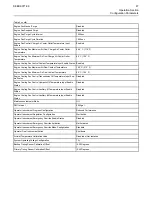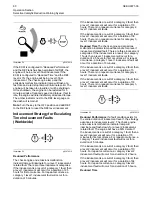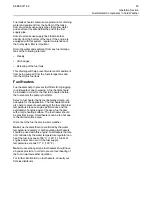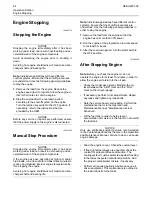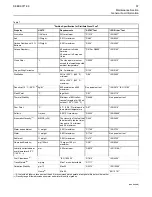
Engine Operation
i06101183
Engine
Operation
Proper
operation
and
maintenance
are
key
factors
in
obtaining
the
maximum
life
and
economy
of
the
engine.
If
the
directions
in
the
Operation
and
Maintenance
Manual
are
followed,
costs
can
be
minimized
and
engine
service
life
can
be
maximized.
The
time
that
is
needed
for
the
engine
to
reach
normal
operating
temperature
can
be
less
than
the
time
taken
for
a
walk-around
inspection
of
the
engine.
The
engine
can
be
operated
at
the
rated
rpm
after
the
engine
is
started
and
after
the
engine
reaches
operating
temperature.
The
engine
will
reach
normal
operating
temperature
sooner
during
a
low
engine
speed
(rpm)
and
during
a
low-power
demand.
This
procedure
is
more
effective
than
idling
the
engine
at
no
load.
The
engine
should
reach
operating
temperature
in
a
few
minutes.
Avoid
excess
idling.
Excessive
idling
causes
carbon
buildup,
engine
slobber
and
soot
loading
of
the
Diesel
Particulate
Filter
(DPF).
These
issues
are
harmful
to
the
engine.
Gauge
readings
should
be
observed
and
the
data
should
be
recorded
frequently
while
the
engine
is
operating.
Comparing
the
data
over
time
will
help
to
determine
normal
readings
for
each
gauge.
Comparing
data
over
time
will
also
help
detect
abnormal
operating
developments.
Significant
changes
in
the
readings
should
be
investigated.
Engine
Operation
and
the
Aftertreatment
System
The
exhaust
gases
and
hydrocarbon
particles
from
the
engine
first
pass
through
Diesel
Oxidation
Catalyst
(DOC).
Some
of
the
gasses
and
matter
are
oxidized
as
they
pass
through
the
DOC.
The
gasses
then
pass
through
the
Diesel
Particulate
Filter
(DPF).
The
DPF
collects
the
soot
and
any
ash
that
is
produced
by
the
combustion
in
the
engine.
During
regeneration,
the
soot
is
converted
into
a
gas
and
the
ash
remains
in
the
DPF.
The
gasses
finally
pass
through
the
Selective
Catalytic
Reduction
(SCR).
Before
the
gasses
pass
through
the
SCR,
Diesel
Exhaust
Fluid
(DEF)
is
injected
into
the
gas
stream.
The
DEF
is
controlled
by
the
Pump
Electronic
Unit
(PEU).
The
mixtures
of
DEF
and
the
exhaust
gas
pass
through
the
SCR
reducing
the
NOx
in
the
exhaust
emissions.
The
engine
software
will
control
the
amount
of
DEF
that
will
be
required
in
order
to
keep
the
exhaust
emission
compliant.
This design of DPF will require a service
maintenance interval. Refer to this Operation and
Maintenance Manual, “Maintenance Interval
Schedule” for more information. The DPF can be
expected to function properly for the useful life of the
engine (emissions durability period), as defined by
regulation, subject to prescribed maintenance
requirements being followed.
i04038637
Engaging
the
Driven
Equipment
1.
Operate the engine at one-half of the rated rpm,
when possible.
2.
Engage the driven equipment without a load on the
equipment, when possible.
Interrupted starts put excessive stress on the drive
train. Interrupted starts also waste fuel. To get the
driven equipment in motion, engage the clutch
smoothly with no load on the equipment. This
method should produce a start that is smooth and
easy. The engine rpm should not increase and the
clutch should not slip.
3.
Ensure that the ranges of the gauges are normal
when the engine is operating at one-half of the
rated rpm. Ensure that all gauges operate
properly.
4.
Increase the engine rpm to the rated rpm. Always
increase the engine rpm to the rated rpm before
the load is applied.
5.
Apply the load. Begin operating the engine at low
load. Check the gauges and equipment for proper
operation. After normal oil pressure is reached and
the temperature gauge begins to move, the engine
may be operated at full load. Check the gauges
and equipment frequently when the engine is
operated under load.
Extended operation at low idle or at reduced load
may cause increased oil consumption and carbon
buildup in the cylinders. This carbon buildup
results in a loss of power and/or poor
performance.
52
SEBU9071-06
Содержание 2206F-E13TA
Страница 126: ......
Страница 128: ...SEBU9071 2020 Perkins Engines Company Limited All Rights Reserved 128 December 2020 ...










